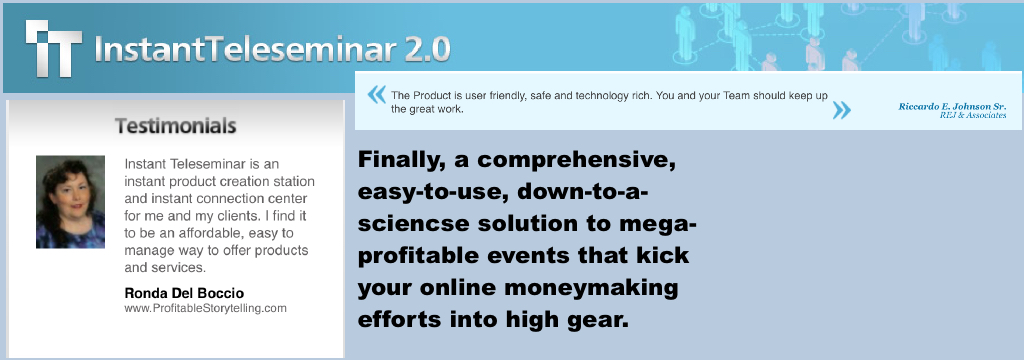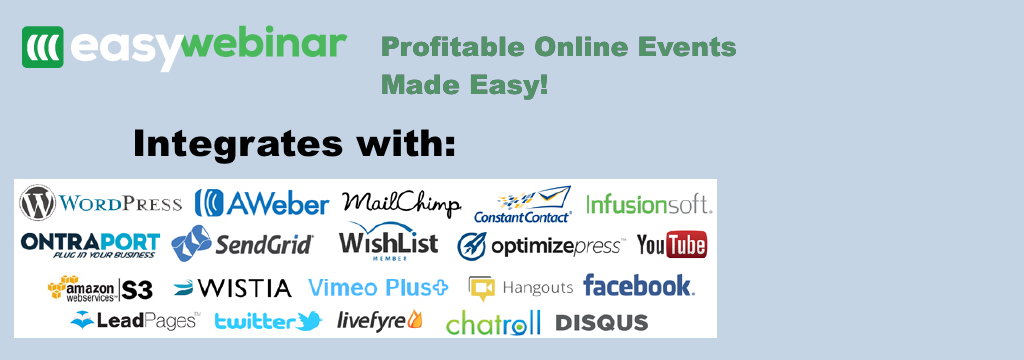Teleseminars and webinars are both powerful methods of teaching or training. Each one has their own benefits, or pluses and minuses. When determining which feature to go for, you will need to ask yourself what are your main goals, what you want to achieve, and what information you need to get across, as well as your audience. This article gives you the difference between working with a teleseminar and a webinar to do your training.
“Aren’t teleseminars being superseded by webinars?”
This is a reasonable question. A webinar, in case you’re not sure, is a seminar that people listen to and watch on the web, via their computer, while a teleseminar involves listening only, via the telephone or computer.
Webinars have numerous disadvantages in comparison to teleseminars:
* Increased preparation time. For a webinar, you need to prepare visuals as well as what you’ll say. Generally there is a Powerpoint-style accompaniment to the talking that must be organized, written and polished ahead of time. If you use photographs or other graphics instead of bulleted summaries of your points, those still must be prepared. The recommended guideline is about one slide per one minute of presentation. That means 60 slides are needed for a one-hour webinar, or a bit fewer if you’re planning a question-and-answer session at the end. For me, webinars take five to ten times as much preparation time as teleseminars.
* Added costs. Webinars require a reliable hosting service that you need to pay for. Some high-quality teleseminar vendors, however, are free.
* Technology barriers. People who have dialup service or Satellite Internet usually cannot participate in webinars. Some corporate folks can’t join a webinar because of their company firewall. And serious technical glitches are multiple times more common with webinars than teleseminars.
* Computer dependency. Participants must be at a computer to access a webinar. If you expect people to participate from the office, this is not a problem. If you target a consumer audience, webinars are less of a fit. Unless you convert a completed webinar to an audio-only presentation, a recorded webinar likewise can’t be accessed in the car or while running or walking as a teleseminar can.
* Bigger learning curve. The last two times I participated in webinar-based conferences, I was required to take part in a one-hour training session first, so I would understand how to operate the controls while presenting. For me, having to simultaneously think about moving the slides and giving my talk makes a webinar much more stressful than a teleseminar. I’m still tense giving a webinar, even after more than a dozen times. The interface is so much simpler for running a teleseminar that only a short run-through is needed, if that, for a first-timer to feel relaxed while presenting.
Webinars do have some advantages over teleseminars:
* Visuals. For teaching how to do something, or for keeping the audience engaged in more than one perceptual channel, webinars rule.
* Higher tech. As the question implied, webinars appear more “advanced” than teleseminars. In some markets this is a significant plus.
* Bells and whistles. One webinar I led last year incorporated real-time polling of the audience. It was very cool to be able to ask a question and get participants’ instant answers. That’s not available with most teleseminar systems.
To make the right decision between these two modes of presentation, think about the subject matter you are teaching, the expectations of your audience, their technology setup, whether it’s a work or non-work presentation, your budget and your own comfort level with the two types of technology.
Good luck with your teaching program!
Veteran teleseminar presenter Marcia Yudkin specializes in high-ticket, high-value teleteaching courses. To find out more about your teleseminar options, download a complimentary copy of “66 Ways to Use Teleseminars to Promote Your Business or Your Cause” at http://www.yudkin.com/teleteach.htm. Discover how to plan, promote and deliver profitable teleseminars, whether you’re an entrepreneur, business or health professional, nonprofit organization or corporate marketer.
More on Teleseminars and Webinars:
7 Deadly Teleseminar & Webinar Sins: Part 2
Once or twice a week I send out new videos, audios and other tips about what’s working now in teleseminar & webinar marketing. I deliver very high content … and you’ll love it. So go ahead give me your name and e-mail and I’ll include …
Publish Date: 10/03/2009
Webinar and Teleseminar Resources
Create Residual Revenue From Your Webinars Tags: Marketing, Promote Your Business, Teleseminars, training, Webinar Posted by





